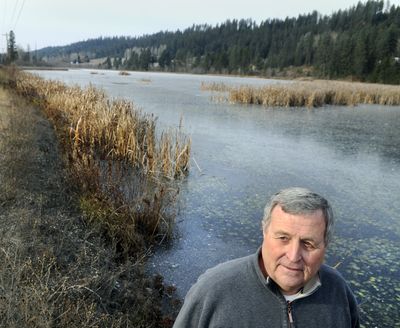State, landowners work together to clean up Little Spokane River

Gary Verbrugge is converting an old cow pasture along the Little Spokane River into a thriving wetland.
Over the past three years, he and others have planted about 15,000 seedlings on 17 acres that his family owns south of Newport, Wash. The young willows, hawthorns and wild roses are still tender slips of plants. But within a few years, they’ll screen the meandering river, providing shade to cool the water and root mass to stabilize the bank.
As the Washington Department of Ecology searches for ways to improve water quality in the Little Spokane River, state officials are looking for ways to engage private landowners like Verbrugge. Landowners hold the key to reducing pollutants such as phosphorus and fecal coliform bacteria in the water. The actions they take on their property also affect how much sediment flows into the river and which river stretches can support native trout.
The Little Spokane is a gem of a stream and an important tributary to the main stem of the Spokane River, said Jon Jones, an Ecology Department program manager who’s developing a pollution control plan for Little Spokane. “It needs to be protected,” he said.
Improving the health of the Little Spokane River also is important to downstream water quality, said Bart Mihailovich, who works for the nonprofit Spokane Riverkeeper program. Fed by the aquifer, the Little Spokane provides a consistent flow of water to the lower Spokane River, he said.
While parts of the Little Spokane watershed are relatively clean, some stretches of the river exceed state standards for phosphorus, coliform bacteria, dissolved oxygen levels and temperature.
On the Spokane River’s main stem, state officials focused on reducing discharges from large municipal and industrial polluters. But in the Little Spokane, few pipes carry contaminants into the river. Instead, most of the pollution comes from “nonpoint sources,” the cumulative actions of thousands of people who live and work in the 700-square-mile watershed, Jones said.
The Little Spokane River begins south of Newport – its headwaters rise from a 25-acre marsh that borders U.S. Highway 2. The river flows more than 50 miles through forests, agricultural fields and rural subdivisions before emptying into the Spokane River at Riverside State Park.
Pollution enters the Little Spokane through septic tanks, agricultural runoff, pet and livestock waste, stormwater from roadways and other sources.
During a watershed tour recently, Jones pointed out manicured lawns in Chattaroy adjacent to the river’s edge. Grass clippings and lawn fertilizers increase the water’s phosphorus levels. Removing native trees and shrubs reduces the shade that cools the water.
Jones is in charge of the Little Spokane River’s total maximum daily load plan. The plan, still in draft form, determines the level of pollutants that can flow into the Little Spokane while still allowing the river to meet water quality standards.
Entities that have state permits to discharge treated water into the Little Spokane River must meet pollution levels set by the Ecology Department. But in the Little Spokane watershed, many of the improvements will come from getting private landowners to voluntarily adopt better land-management practices, Jones said.
Last year, a dairy owner agreed to put up fencing to keep 160 cows out of a tributary creek to the Little Spokane. The Ecology Department worked with the Spokane County Conservation District to help the landowner get a $60,000 grant to pay for the fencing and an alternative water source for the cows.
Jones also hopes to identify sources of grant money for property owners who re-establish streamside buffers of native trees and shrubs. “There are some beautiful native plants like red osier dogwood,” he said. “They sell it at Home Depot for landscaping.”
Verbrugge’s wetlands restoration is an extreme example of what buffers can do. The 17 acres was once a community pasture for Scotia, a short-lived timber community that sprung up during the early 1900s.
Verbrugge worked with the Pend Oreille County Conservation District and the Natural Resources Conversation Service to undo the harm done decades ago. The straightened river channel was re-engineered to meander. Willows and alders were planted in marshy spots. Conifer seedlings went into drier ground.
Wildlife already find the old pasture more inviting, said Verbrugge, who sees more deer, moose and great blue herons along the river. Students from Whitworth University’s Environmental Studies Program are monitoring water quality and temperature. Motion-sensing cameras will track wildlife use.
As the river returns to a natural state, the monitoring will provide a scientific record of the changes, Verbrugge said.